5 stories to celebrate National Community Cat Day

If you happen to cross paths with any cats in your neighborhood on October 16, make sure to bid them an extra hearty hello. It’s their day, after all. That’s right: It’s National Community Cat Day.
To some, an official day to recognize community cats might sound a bit trivial. But it’s an important day, especially when you consider that more than two million cats enter shelters every year in this country and about 20% of them don’t make it out alive.
To reach our goal of bringing every shelter and every community to no-kill by the end of 2025, Best Friends is laser-focused on replicable solutions that will save our nation’s cats and kittens. In fact, the save rate for cats has been found to improve by 80% in areas that have community cat programs.
In honor of National Community Cat Day, here are five stories about community cat programs — people who didn’t plan to take care of cats, but do, and the felines who today are thriving in the communities they call home.
How a pilot became a community cat advocate
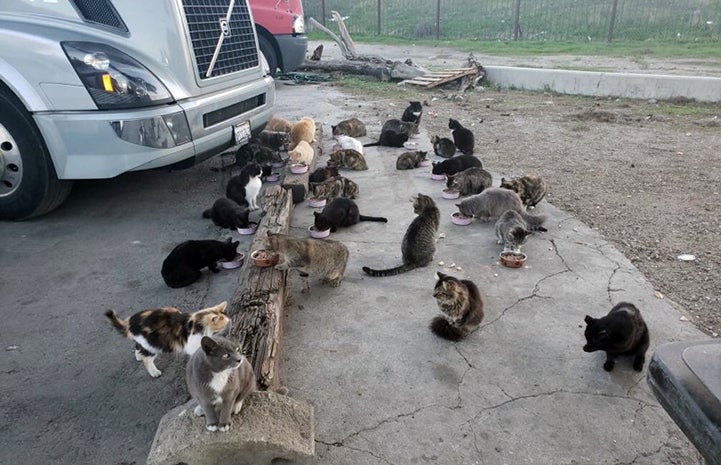
When Malcolm, the sole cargo pilot at a transportation company in Riverside, California, saw how many cats were living on-site at company headquarters, he knew he had to do something to help them. So, he contacted the Riverside County Department of Animal Services for assistance.
At first, he thought the best solution for the cats was to bring them to the shelter where they could be placed for adoption, but then he learned that Riverside County takes in thousands of cats a year. He also learned about the shelter’s partnership with Best Friends to implement a community cat program.
Malcolm and fellow employees at the transportation company quickly got on board to help with efforts to utilize trap-neuter-vaccinate-return (TNVR) as the solution for the cats. With TNVR, are humanely trapped, spayed or neutered, vaccinated and returned to their outdoor homes. Once the cats were returned, they were back to the system they already had in place to care for the cats. As for Malcolm, he took it a step further by becoming a TNVR advocate.
Today Malcolm opens his own home to cats and kittens needing a temporary safe space while he works to find a positive outcome for them. He also traps cats in his neighborhood. “You’ve got to find people where you are,” says Malcolm. “Everyone has different things they can offer: time, money, supplies, space. When you come together you can make a big impact.” Read the full story here.
Keeping healthy, friendly cats out of shelters
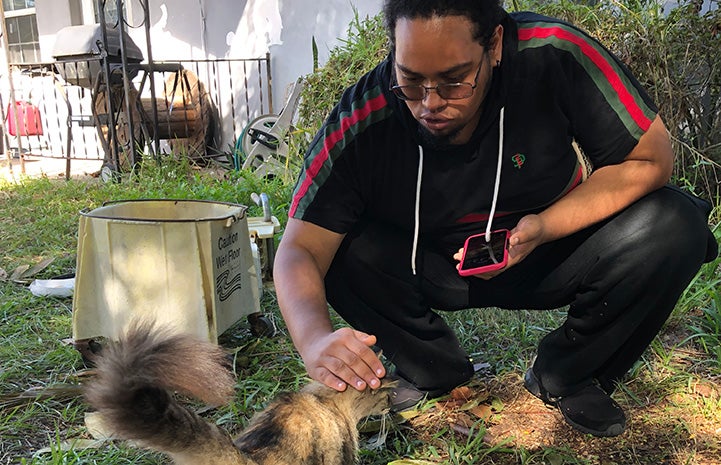
Derek started caring for MittMitts the cat when his elderly neighbor (the previous caregiver) died. In fact, he was taking care of several of his neighbors’ cats. Later, when MittMitts disappeared one day, it turned out that another neighbor eventually found her and took her to the shelter, perhaps not realizing that she might be missed by someone who was already looking after her.
Meanwhile, the Best Friends staff was working with the shelter to utilize TNVR to deal with cats in the neighborhood. That’s how MittMitts eventually made her way back to the only home she knew and into Derek’s care.
When the two were reunited, Derek buried his face in MittMitts’ fur and gave her a big hug of relief. He started taking selfies and posted them online. He even called friends to let them know that MitMitts was finally home. Read the full story here.
Collaboration is the key to saving cats in Valdosta, Georgia
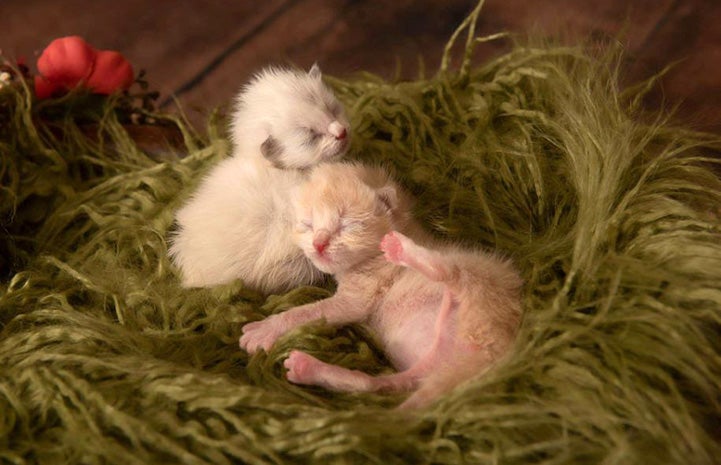
When Emily Smith became the director of operations at the Humane Society of Valdosta/Lowndes County (HSVLC) in 2019, the shelter’s save rate for cats was 51%. At the time, little was being done to help cats, besides some community TNVR efforts, but Emily was determined to change that.
First, she contacted the Atlanta Humane Society and began setting up a transport for cats every other week. Then she connected with Best Friends in Atlanta and LifeLine Animal Project to take in cats from HSVLC as well. She also found ways to help the ill or injured cats landing at the shelter — cats who rarely made it out alive. And in March of 2019, the shelter opened a neonatal intensive care unit to help kittens less than five weeks old.
As of 2020, the save rate for cats rose to 68.5%. While there’s still work to be done, Emily is able to see what’s possible for cats in her community. “Even though we still have a way to go, I believe that no-kill is now a tangible, very real future for Lowndes County,” she says. Read the full story here.
Critically injured community cat gets a second chance
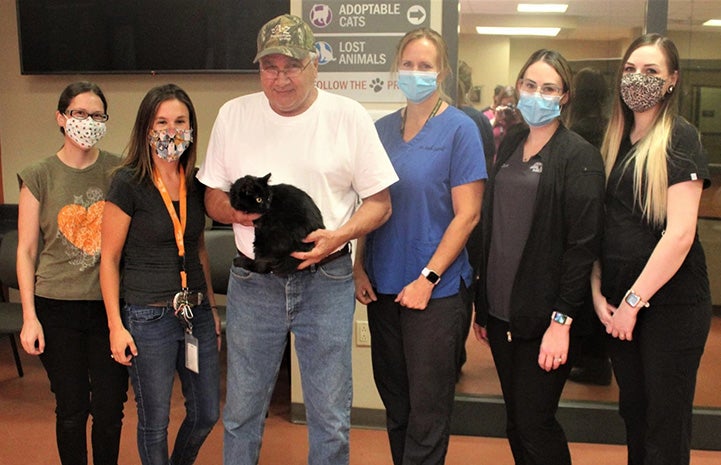
Corona the cat means the world to David. Having showed up outside his home in Stanislaus County, California, just before the coronavirus hit, she became a source of joy in the following months. In fact, David named her Corona as a way to make the pandemic a little more positive.
Arriving one day at David’s home with serious injuries, she was rushed to an emergency veterinarian, and the news wasn’t good: The injuries were extensive. Overcome with worry but not out of hope, he brought her to the Stanislaus Animal Services Agency.
That’s when he learned about the shelter’s partnership with Best Friends Animal Society, which included a community cat program. Amanda Kokaram, community cat program coordinator for Best Friends, remembers meeting David and Corona at the shelter. “He was so concerned about her and wanted to see her get help,” she says. ”We knew that we wanted to do our best to save her.”
The shelter’s medical team treated the cat’s injuries, and then she went back home with David. In fact, when she was ready to leave the shelter, he showed up before it opened, eager to be reunited with the golden-eyed cat. The staff couldn’t wait for the reunion to happen, either. And yes, it was as teary-eyed as you can imagine. Read the full story here.
Doing right by outdoor cats: Here’s how
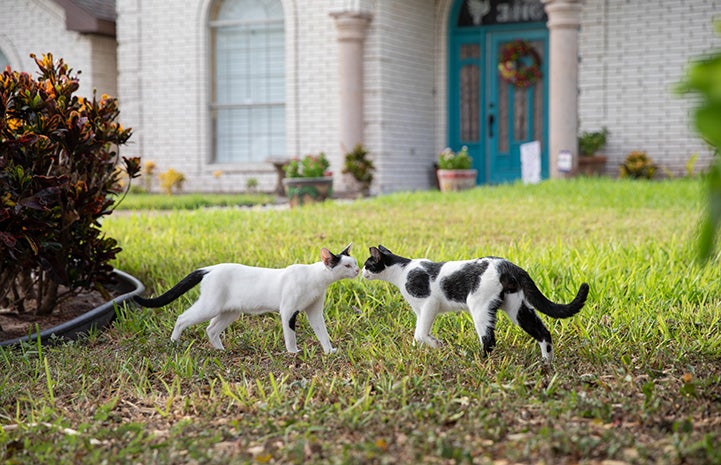
What should you do if you see cats roaming in your neighborhood? Is it best to try to trap them and take them the nearest shelter, post flyers around the neighborhood, or go knocking door-to-door until you find their people?
With so many options, it’s hard to know what’s the best course of action, especially when you learn a couple of hard facts: Few cats are reunited with their people once they enter shelters, and not as many people as you think go out to the shelter looking for their lost pets.
Instead of taking them to the shelter, consider contacting neighbors via social media platforms (such as Nextdoor) to find out if others know the scoop about the cats you’re trying to help. You could also hang flyers around the neighborhood, and yes, even ask neighbors if they have the 411 about the felines in question.
Another important thing you’ll want to do is make sure that the cats are spayed or neutered. If not, contact the local shelter or rescue group in your community for help with humanely trapping, neutering, vaccinating and returning cats to the place where they were originally living. If it’s clear that the cats are already spayed or neutered, have nice coats and look fed and healthy, chances are good they are being cared for by someone or a few people.
If that’s the case, have a chat with neighbors and learn where they stand on outdoor cats. Hopefully, with lines of communication open, you can work out a plan so that their cats can remain outside, be well cared for and remain happy for many years to come. Read the full story.
How to help cats in your community
No matter where you live, you can help save cats' lives. There are so many ways to get involved and make a real impact. Plus, it can be a lot of fun, too!
Get involved for cats near you
Read more
Cat goes from touch-me-not to grumbly biscuit maker
Scared mama cat goes from stressed to spotlight
Senior dog finds calling as kitten dad
Photos by Sarah Ause Kichas and courtesy of Malcolm and Alesha Davidson, Lisa Goldstein, Humane Society of Valdosta Lowndes County and Stanislaus Animal Services Agency